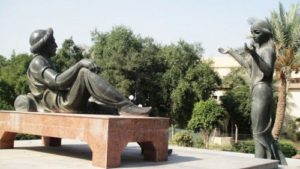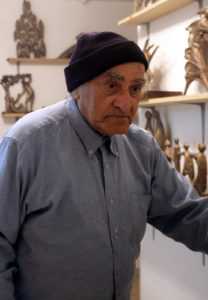A sculpture by Mohammed Ghani Hikmat, inspired by a story in “One Thousand and One Nights,” in a park in Baghdad. CreditSabah Arar/Agence France-Presse — Getty Images

Mohammed Ghani Hikmat, the Iraqi sculptor who created many of Baghdad’s most famous landmarks and who led the effort to recover works of art looted from the National Museum of Iraq after the fall of Saddam Hussein, died on Sept. 12 in Amman, Jordan, where he had gone for medical treatment. He was 82.
The cause was kidney failure, his son, Yasir Mohammed, said.
In the 1960s and ’70s, Mr. Hikmat created many sculptures that were inspired by the Middle Eastern fables “1,001 Nights.” Placed in bustling parts of the city, they include “Kahramana,” a sculpture of a woman pouring oil on thieves hiding in jars, and statues of the two main characters of “1,001 Nights,” King Shahriyar and Queen Scheherazade. Other sculptures and wood carvings of his depicted idealized scenes of everyday Iraqi life.
Mr. Hikmat fled Iraq a month before the United States-led invasion in 2003 and returned shortly after the Hussein regime fell. He found that looters had stolen about 150 of his works from the National Museum and that his studio and many of his sculptures there had been damaged.
“My father was so devastated, because he saw that people had broken his work; he wished they had just stolen it,” Mr. Mohammed said. “He told me that if they had stolen it, we could try and get it back years later and put it in a gallery. But they broke and it could never be fixed.”
In the wake of the American occupation, Mr. Hikmat left Iraq for seven years but remained in the Middle East and formed a committee to buy back many of Iraq’s artworks stolen in the looting. The program has recovered about 100 pieces of art. He returned to live in Baghdad in the past year.
Photo

Mr. Hikmat at his workshop in Jordan in 2009.CreditKhalil Mazraawi/Agence France-Presse — Getty Images
Mr. Hikmat also had a role in creating one of Baghdad’s most famous sculptures, the crossed-sword arches that became of symbol of the Hussein dictatorship. Mr. Hussein had ordered them built as a symbol of Iraq’s might during its war with Iran.
After Khalid al-Rahal, who designed the arches, died in 1987, Mr. Hikmat completed them. When the arches were dedicated in 1989, Mr. Hussein rode a white horse through them.
“It was an official order from the presidential office to complete it because Khalid al-Rahal was his friend,” Mr. Mohammed said. “He was the only one who was left from his generation of artists, so there wasn’t any other sculptor with such experience who could complete a work of this size.”
The government began dismantling the swords in 2007 but stopped after protests. It began restoring the arches earlier this year, saying they were part of the country’s history.
Mr. Hikmat was born in the Kadumiya neighborhood of Baghdad in 1929. He graduated from Iraq’s Fine Arts Institute in 1953 and from the Academy of Fine Arts in Rome four years later.
In addition to his son, Mr. Hikmat is survived by a daughter, Hajeer Mohammed Ghani, and his wife, Gaya al-Rahal.
Yasir Ghazi and Zaid Thaker contributed reporting from Baghdad.Source: The New York Times, SEPT. 21, 2011








Comment here